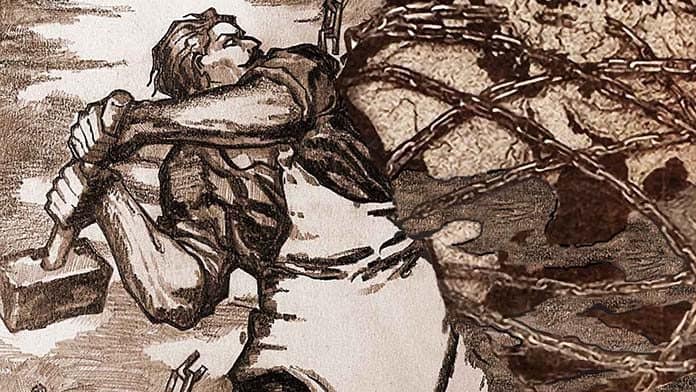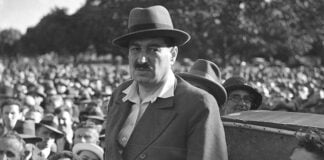Adam Adelpour continues our series on war and workers’ resistance, looking at Australian unions’ support for workers’ struggles in the Pacific against imperialism in the 1920s
The Pan-Pacific Trade Union (PPTU) was an inspiring example of working class solidarity and opposition to war—something that is urgently needed today.
The Asia Pacific today is a tinderbox of imperialist tensions. The Albanese government’s acquisition of $368 billion nuclear subs positions Australia alongside US imperialism in an attempt to encircle China.
The First World War produced a working class radicalisation against war and imperialism, with unionists central to the defeat of two plebiscites on conscription.
Working class people died in their millions on the battlefields to defend the wealth and profits of the rich, while at home living standards faced a savage attack as part of the war effort.
The post-war period looked to be incubating another conflict between imperialist powers in the Pacific. By 1921 there was already the serious possibility of war between Japan and the US.
In response, unionists in Australia attempted to establish links with unionists across the Pacific to oppose war. This was the backdrop to the formation of the PPTU.
Initial efforts were modelled on the Council of Action formed by unions to oppose British military intervention against the Bolsheviks following the Russian revolution. The All-Australian Trade Union Congress of 1921 established a similar Council of Action to organise the workers of the Pacific to prevent a future war.
The initial attempts were faltering. The first Council of Action collapsed despite enjoying wide support. However, the idea was revived by the NSW Labor Council in 1926, strongly influenced at the time by the newly formed Communist Party of Australia (CPA).
The CPA was affiliated to the Communist International or Comintern, set up by the Bolsheviks in 1919 to spread international revolution and grouping together communist parties across the world. Its international connections, resources and influence helped make the PPTU a reality.
The CPA itself, however, remained a small force through the 1920s.
Support for the PPTU reflected the much wider support for international working class solidarity across the trade union movement.
Following the initiatives by the NSW Labor Council, the Third All-Australian Trade Union Congress in 1926 agreed to continue to support the Pan-Pacific movement. It appealed to “all workers of the Pacific” to unite “against international capitalism and its war preparations”.
A full Pan-Pacific conference was planned for Canton (now called Guangzhou) on May Day 1927 with invitations to labour organisations in China, Japan, Russia, India, Indonesia, the Philippines, Canada and the United States.
The conference had to be moved to the city of Hankow (today’s Wuhan) at the last minute due to the nationalist Guomindang’s assault on the Chinese Communists and the workers’ movement through a series of massacres. Delegates from Australia were prevented from attending by the federal government.
Despite this, the Pan-Pacific movement adopted a set of aims pledging to wage a joint struggle against the danger of war in the Pacific, to support the Chinese revolution against imperialism, to support all oppressed peoples of the Pacific in liberating themselves from imperialist control, and in opposition to “all racial and national barriers and prejudices which still divide the exploited classes and oppressed peoples to the advantage of the exploiters and oppressors”.
International solidarity
The PPTU was closely linked to the Red International of Labour Unions affiliated to the Comintern. Between 1927 and 1932 it helped build communication, co-ordination and solidarity between unionists across the Pacific.
The Australian Council of Trade Unions (ACTU) agreed to affiliate to the PPTU at its founding conference in May 1927. Australia became the editorial headquarters of the Pan-Pacific Trade Union Secretariat following its expulsion from China later that year, publishing the Pan-Pacific Worker.
In Australia, some of its most fruitful work focused on building solidarity with the anti-colonial struggle in China against British, US and Japanese imperialism.
This is particularly notable because it was done under the White Australia Policy when anti-Chinese racism was pushed intensely by the ruling class, as well as right-wing union officials like those in the Australian Workers Union and the Labor Party.
The Communist Party press in the late 1920s and early 1930s carried a steady stream of reports about the “Hands off China” campaign and meetings, union resolutions and rallies in solidarity with China.
In 1926 the Labor Daily reported a rally of 2000 in the Sydney Domain to protest against “the action of the Governments of England, Japan and America in intervening in the internal affairs of China”. The rally was chaired by Jock Garden, Secretary of the NSW Labor Council and at the time a member of the CPA.
That year had seen a major rising against foreign colonialism in China. At the time China was divided among competing imperialist powers, which had set up footholds on Chinese soil, sponsored warlords to serve their interests and exploited the Chinese population and its resources.
In 1927 the Workers Weekly, a CPA paper, carried a call for union solidarity action against British intervention in China. It said, “The British War Office is now negotiating with the Federal Government for the supply of foodstuffs for the armies that are menacing the Chinese masses.”
The same article reported that the NSW Council of the Australian Railwaymen’s Union had carried a resolution “refusing to carry on the railway any goods intended for war purposes in China”. The article declared that, “Every tin of jam, or bag of flour consigned to China is a weapon in the hands of the oppressors of the Chinese workers.”
Paving the way
PPTU agitation laid the basis for actions even after the organisation itself was no longer a real force.
In 1937 Japan launched a full-scale invasion on China. Three months later the Chinese crew of the SS Silkworth deserted ship in Newcastle. The ship sailed under the British flag and was chartered by the Japanese to carry flour and gypsum to the Japanese puppet state “Manchukuo”.
After the ship landed in Newcastle the crew quickly discovered that Japan had invaded Shanghai and Nanjing in southern China. Some of the crew were from these cities. The Chinese crew objected to both their treatment on the ship, including beatings by the Japanese captain, and to transporting chemicals and provisions for Japanese forces. The situation quickly escalated and within hours the crew had deserted.
Anti-Japanese sentiment was growing on a nationalist basis as the build up to the Second World War began. But working class solidarity remained essential as the action still carried great risks for the crew. Earle Page, the Minister of Commerce, called for the Immigration Act to be used against the men. Under the racist laws of the time, the deportation of “coloureds” for absence from a ship without permission was common and the men also faced six months’ imprisonment.
The crew gained the support of the Newcastle CPA branch and unions. They went to the Trades Hall where delegates voted unanimously to support them. There were arrangements made for the crew to visit the Chinese Consul in Sydney and to tour worksites of striking miners to build solidarity with their cause.
The evening after the ship’s arrival a special meeting was held at Trades Hall with the help of the local Chinese community. During the speeches some of the crew slipped into the crowd and six were secretly whisked away and smuggled to Sydney. Another 30 crew members were later arrested.
In the end the men avoided deportation, negotiated their repatriation and the SS Silkworth was delayed for ten days. The SS Silkworth episode is distinctive for the particular challenge it posed to the racist immigration laws.
Another 12 months later the famous Dalfram dispute at Port Kembla saw wharfies refuse to load pig iron for transport to Japan. While the Dalfram dispute is celebrated as an important moment in union action against war, it was also significantly coloured by Australian nationalism and imperialist competition with Japan.
Lessons
The CPA was the driving force behind this campaign of international solidarity. But after 1928 communist parties around the world adopted sectarian policies and began denouncing reformist parties like the Labor Party as “social fascist”, a designation that was also applied to union federations like the ACTU.
This turn was a product of Stalin’s growing influence in the Comintern and his desire to consolidate his position as leader of a new counter-revolutionary bureaucracy in Russia. As a consequence, the PPTU became increasingly cut off from the wider union movement.
The PPTU also drew opposition from the right-wing AWU, as well as the conservative government, for its anti-racist stance, which was said to undermine support for the White Australia policy. Much of the left of the union movement were willing to join campaigns in solidarity with workers in China and the Pacific but remained supporters of White Australia. For this reason the PPTU did not openly oppose the White Australia Policy.
Nevertheless, its anti-imperialist propaganda and solidarity actions did help undermine the racism dividing workers in Australia from those in the region, and associated with immigration restrictions and the White Australia policy.
Much mainstream history paints racism and the White Australia policy as something uniformly championed by unions and workers in Australia in the first half of the 20th century. But this mistaken version of history obscures the important examples of anti-racist struggle from the period. These can arm us to fight imperialism today.
Under the shadow of the AUKUS nuclear subs deal and potential war with China this history shows how it is possible to win mass working class opposition to militarism and war.






